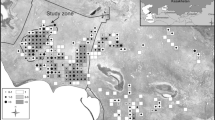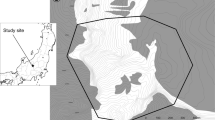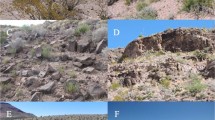Abstract
Animal mating systems provide key insights into the relationship between evolutionary processes and ecological factors such as the spatio-temporal fluctuation of resource abundance. Characteristics of mating systems can be inferred from the spatial distribution of conspecifics and the arrangement of reproductive pairs. Here we used home-range size and overlap for Thrichomys fosteri in the Brazilian Pantanal to infer the mating system on this echimyid rodent. Our aims were to verify the existence of sexual dimorphism, to test whether home-range size varied with the sex and body weight of the individuals, to evaluate the degree of home-range overlap, to estimate mean population density, and to infer individuals’ mating system. Twenty one individuals (15 males and six females) were radio tracked from 14 to 349 days, with the number of locations by individuals ranging from 19 to 193 locations. There was a male-biased sexual dimorphism in body weight where males were 1.36 times heavier than females. Males’ home-range size increased with their body weight, while for females there was no relationship. There was extensive home-range overlap between both sexes, and no evidence of territoriality. Mean population density ranged from 0.9 to 3.03 individuals/ha. Our results indicate that multiple mates were available for both sexes, characterizing a promiscuous mating system.



Similar content being viewed by others
References
Adler GH (2011) Spacing patterns and social mating systems of Echimyid rodents. J Mammal 92:31–38. https://doi.org/10.1644/09-MAMM-S-395.1
Adler GH, Endries M, Piotter S (1997) Spacing patterns within populations of a tropical forest rodent, Proechimys semispinosus, on five Panamanian islands. J Zool 241:43–53. https://doi.org/10.1111/j.1469-7998.1997.tb05498.x
Alho CJR, Campos ZMS, Gonçalves HC (1987) Ecologia de capivara (Hydrochaeris hydrochaeris, Rodentia) do Pantanal: I Habitats, densidades e tamanho de grupo. Braz J Biol 47:87–97
Almeida AJ, Freitas MMF, Talamoni SA (2013) Use of space by the neotropical caviomorph rodent Thrichomys apereoides (Rodentia: Echimyidae). Zoologia 30:35–42. https://doi.org/10.1590/S1984-46702013000100004
Andreazzi CSD, Rademaker V, Gentile R, Herrera HM, Jansen AM, D’Andrea PS (2011) Population ecology of small rodents and marsupials in a semi-deciduous tropical forest of the southeast Pantanal, Brazil. Zoologia 28:762–770. https://doi.org/10.1590/S1984-46702011000600009
Antunes PC (2009) Uso de habitat e partição do espaço entre três espécies de pequenos mamíferos simpátricos no Pantanal Sul-Mato-Grossense, Brasil. M.S. thesis, Federal University of Mato Grosso do Sul, Campo Grande, Mato Grosso do Sul, Brazil
Antunes PC (2014) Ecologia de Thrichomys fosteri (Rodentia; Echimyidae) no Pantanal: dieta, área de vida e seleção de recursos. Ph.D. dissertation, Federal University of Rio de Janeiro, Rio de Janeiro, Brazil
Antunes PC, Oliveira-Santos LGR, Tomas WM, Forester JD, Fernandez FAS (2016) Disentangling the effects of habitat, food, and intraspecific competition on resource selection by the spiny rat, Thrichomys fosteri. J Mammal 97:1738–1744. https://doi.org/10.1093/jmammal/gyw140
Aragona M (2008) História natural, biologia reprodutiva, parâmetros populacionais e comunidades de pequenos mamíferos não voadores em três habitats florestados do Pantanal de Poconé, MT. Ph.D. dissertation, Universidade de Brasília, Brasília, Brazil
Asher M, Oliveira ES, Sachser N (2004) Social system and spatial organization of wild guinea pigs (Cavia aperea) in a natural population. J Mammal 85:788–796. https://doi.org/10.1644/BNS-012
Asher M, Lippmann T, Epplen J, Kraus C, Trillmich F, Sachser N (2008) Large males dominate: ecology, social organization, and mating system of wild cavies, the ancestors of the guinea pig. Behav Ecol Sociobiol 62:1509–1521. https://doi.org/10.1007/s00265-008-0580-x
Bond ML, Wolff JO (1999) Does access to females or competition among males limit male home-range size in a promiscuous rodent? J Mammal 80:1243–1250. https://doi.org/10.2307/1383174
Boonstra R, Gilbert BS, Krebs CJ (1993) Mating systems and sexual dimorphism in mass in microtines. J Mammal 74:224–229. https://doi.org/10.2307/1381924
Calenge C (2006) The package adehabitat for the R software: a tool for the analysis of space and habitat use by animals. Ecol Model 197:516–519. https://doi.org/10.1016/j.ecolmodel.2006.03.017
D’Elía G, Myers P (2014) On Paraguayan Thrichomys (Hystricognathi: Echimyidae): the distinctiveness of Thrichomys fosteri Thomas, 1903. Therya 5:153–166. https://doi.org/10.12933/therya-14-182
EMBRAPA (1984) Boletim agrometeorológico: cinco anos de observações meteorológicas, Corumbá, MS, 1977–1981. EMBRAPA, UEPAE de Corumbá, Corumbá
Endries MJ, Adler GH (2005) Spacing patterns of a tropical forest rodent, the spiny rat (Proechimys semispinosus), in Panama. J Zool Lond 265:147–155. https://doi.org/10.1017/S0952836904006144
Fieberg J, Kochanny CO (2005) Quantifying home-range overlap: the importance of the utilization distribution. J Wildl Manag 69:1346–1359. https://doi.org/10.2193/0022-541X(2005)69[1346:QHOTIO]2.0.CO;2
Guichón ML, Borgnia M, Righi CF, Cassini GH, Cassini MH (2003) Social behavior and group formation in the coypu (Myocastor coypus) in the Argentinean Pampas. J Mammal 84:254–262. https://doi.org/10.1644/1545-1542(2003)084%3c0254:SBAGFI%3e2.0.CO;2
Harestad AS, Bunnel FL (1979) Home range and body weight: a reevaluation. Ecology 60:389–402. https://doi.org/10.2307/1937667
Heske EJ, Ostfeld RS (1990) Sexual dimorphism in size, relative size of testes, and mating systems in North American voles. J Mammal 71:510–519. https://doi.org/10.2307/1381789
Kelt DA, Van Vuren DH (2001) The ecology and macroecology of mammalian home range area. Am Nat 157:637–645. https://doi.org/10.1086/320621
Kraus C, Künkele J, Trillmich F (2003) Spacing behaviour and its implications for the mating system of a precocial small mammal: an almost asocial cavy Cavia magna? Anim Behav 66:225–238. https://doi.org/10.1006/anbe.2003.2192
Laake J (2013) RMark: an r interface for analysis of capture-recapture data with MARK. AFSC Processed Rep. 2013-01, Alaska Fish. Sci. Cent., NOAA, Natl. Mar. Fish. Serv., Seattle, WA
Lacher TE, Alho CJR (1989) Microhabitat use among small mammals in the Brazilian Pantanal. J Mammal 70:396–401. https://doi.org/10.2307/1381526
Lindstedt SL, Miller BJ, Buskirk SW (1986) Home range, time and body size in mammals. Ecology 67:413–418. https://doi.org/10.2307/1938584
Loretto D, Vieira MV (2005) The effects of reproductive and climatic seasons on movements in the black-eared opossum (Didelphis aurita Wied-Neuwied, 1826). J Mammal 86:287–293. https://doi.org/10.1644/BEH-117.1
Madison DM, McShea WJ (1987) Seasonal changes in reproductive tolerance, spacing, and social organization in meadow voles: a microtine model. Am Zool 27:899–908. https://doi.org/10.1093/icb/27.3.899
Maher CR, Burger JR (2011) Intraspecific variation in space use, group size, and mating systems of caviomorph rodents. J Mammal 92:54–64. https://doi.org/10.1644/09-MAMM-S-317.1
Mares MA, Watson MD, Lacher TE (1976) Home range perturbations in Tamias striatus. Oecologia 25:1–12. https://doi.org/10.1007/BF00345029
McNab BK (1963) Bioenergetics and the determination of home range size. Am Nat 97:133–140. https://doi.org/10.1086/282264
Mohr CO (1947) Table of equivalent populations of North American small mammals. Am Midl Nat 37:223–249. https://doi.org/10.2307/2421652
Nascimento FF, Lazar A, Menezes AN, Durans ADM, Moreira JC, Salazar-Bravo J, Andrea PSD, Bonvicino CR (2013) The role of historical barriers in the diversification processes in open vegetation formations during the Miocene/Pliocene using an ancient rodent lineage as a model. PLoS One 8:e61924. https://doi.org/10.1371/journal.pone.0061924
Orians GH (1969) On the evolution of mating systems in birds and mammals. Am Nat 103:589–603. https://doi.org/10.1086/282628
Ostfeld RS (1985) Limiting resources and territoriality in microtine rodents. Am Nat 126:1–15. https://doi.org/10.1086/284391
Ostfeld RS (1990) The ecology of territoriality in small mammals. Trend Ecol Evol 5:411–415. https://doi.org/10.1016/0169-5347(90)90026-A
Ostfeld RS, Heske EJ (1993) Sexual dimorphism and mating systems in voles. J Mammal 74:230–233. https://doi.org/10.2307/1381925
Otis DL, Burnham KP, White GC, Anderson DR (1978) Statistical inference from capture data on closed animal populations. Wildl Monogr 62: 3–35. https://www.jstor.org/stable/3830650.
R Core Team (2012) R: a language and environment for statistical computing. R Foundation for Statistical Computing, Vienna, Austria. www.R-project.org/. Accessed 10 May 2013
Rodela LG (2006) Unidades de vegetação e pastagens nativas do Pantanal da Nhecolândia, Mato Grosso do Sul. Ph.D. dissertation, Universidade de São Paulo, São Paulo, São Paulo, Brazil
Scharadin C, Pillay N (2006) Female striped mice (Rhabdomys pumilio) change their home ranges in response to seasonal variation in food availability. Behav Ecol 17:452–458. https://doi.org/10.1093/beheco/arj047
Schulte-Hestedde AI (2007) Sexual size dimorphism in rodents. In: Wolff O, Sherman PW (eds) Rodent societies: an ecological and evolutionary perspective. The University of Chicago Press, Chicago, pp 115–128
Seamon JO, Adler GH (1999) Short-term use of space by a neotropical forest rodent, Proechimys semispinosus. J Mammal 80:899–904. https://doi.org/10.2307/1383258
Sikes RS, the Animal Care and Use Committee of the American Society of Mammalogists (2016) Guidelines of the American Society of Mammalogists for the use of wild mammals in research and education. J Mammal 97:663–688. https://doi.org/10.1644/10-MAMM-F-355.1
Silva RB, Vieira EM, Izar P (2008) Social monogamy and biparental care of the neotropical southern bamboo rat (Kannabateomys amblyonyx). J Mammal 89:1464–1472. https://doi.org/10.1644/07-MAMM-A-215.1
Soisalo MK, Cavalcanti SMC (2006) Estimating the density of a jaguar population in the Brazilian Pantanal using camera-traps and capture–recapture sampling in combination with GPS radio-telemetry. Biol Conserv. https://doi.org/10.1016/j.biocon.2005.11.023
Sunquist MP, Austad SN, Sunquist F (1987) Movement patterns and home range in the common opossum (Didelphis marsupialis). J Mammal 68:173–176. https://doi.org/10.2307/1381069
Teixeira BR, Roque ALR, Barreiros-Gómez SC, Borodin PM, Jansen AM, D’Andrea PS (2005) Maintenance and breeding of Thrichomys (Trouessart, 1880) (Rodentia: Echimyidae) in captivity. Mem Inst Oswaldo Cruz 100:527–530. https://doi.org/10.1590/S0074-02762005000600005
Waterman J (2007) Male mating strategies in rodents. In: Wolff JO, Sherman PW (eds) Rodent societies: an ecological and evolutionary perspective. The University of Chicago Press, Chicago, pp 28–41
Williams B, Nichols J, Conroy M (2002) Analysis and management of animal populations. Academic Press, Cambridge
Wolff JO (1985) The effects of density, food, and interspecific interference on home range size in Peromyscus leucopus and Peromyscus maniculatus. Can J Zool 63:2657–2662. https://doi.org/10.1139/z85-397
Wolff JO (1993) Why are female small mammals territorial? Oikos 68:364–370. https://doi.org/10.2307/3544853
Worton BJ (1989) Kernel methods for estimating the utilization distribution in home-range studies. Ecology 70:164–168. https://doi.org/10.2307/1938423
Worton BJ (1995) Using Monte Carlo Simulation to evaluate kernel-based home range estimators. J Wildl Manag 59:794–800. https://doi.org/10.2307/3801959
Wynne-Edwards VC (1962) Animal dispersion in relation to social behaviour. Oliver and Boyd, Edinburgh https://doi.org/10.1126/science.138.3548.1389-a
Acknowledgements
PC Antunes, LGR Oliveira-Santos and FAS Fernandez were supported by National Council for Scientific and Technological Development (CNPq). We thank Alan Bolzan, Everton Miranda, Ismael V. Brack and Rafael P. Ferreira for the valuable help with field work. We acknowledge the Brazilian Agricultural Research Corporation (Embrapa Pantanal; Project SEG 02.10.06.007.00.00) for logistical and financial support.
Author information
Authors and Affiliations
Corresponding author
Additional information
Publisher's Note
Springer Nature remains neutral with regard to jurisdictional claims in published maps and institutional affiliations.
Handling editor: Raquel Monclús.
Electronic supplementary material
Below is the link to the electronic supplementary material.
Rights and permissions
About this article
Cite this article
Antunes, P., Oliveira-Santos, L.G.R., dos Santos, T.M.R. et al. Mating system of Thrichomys fosteri in the Brazilian Pantanal: spatial patterns indicate promiscuity. Mamm Biol 100, 365–375 (2020). https://doi.org/10.1007/s42991-020-00040-y
Received:
Accepted:
Published:
Issue Date:
DOI: https://doi.org/10.1007/s42991-020-00040-y




